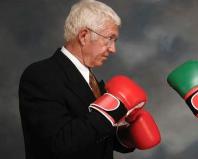What is DRL? Types and characteristics of mercury lamps. Lamps drl, dnat, luminous flux
Electricians joke:
A screw driven in with a hammer holds better
than a nail screwed in with a screwdriver!
The fuse is always the last one to blow...
At the last swimming competition, electrician Petrov suddenly closed the top three!...
There are two sockets on the wall: 220 volts and 380.
There is an inscription between them: feel the difference...
In our high-rise building, a sewer system burst, which flooded the switchboard, causing the lights to go out...
And at this time, a lift operator, a plumber and an electrician were riding in the elevator...
Nurse: Doctor, it seems we lost him!
Doctor: Nothing, nothing. Now the electricians will fix the light, and we’ll find...
- Have you tested three-phase current?
- And he himself walked over me yesterday...
I am selling wire and cable from the base. At night...
Electrician Sidorov fell from the pole and cursed politely...
The most accurate and succinct description of Moscow from a bird's eye view was given last Monday by electrician Sidorchuk, who the day before, on Friday, got tangled in wires on upper tier TV towers...
The customer asks the builder: - Sorry, isn't it too much? thin walls at this house? - Normal. There will also be wallpaper...
An electrician makes mistakes twice in his life. The first time - when choosing a profession...
Today at 10.00 am, a simple Russian electrician Sidorov made the discovery of the century.
At 10.30 the second eyelid opened...
If teaching is light, then the teacher is a lamp!
When digging a hole for someone else, be careful not to bump into a high-voltage cable!
At our construction site, there are two possible scenarios for the development of events: worst and most unlikely...
Ivanov, I'm afraid we are forced to replace you with a man...
You can even drown in a puddle... Especially if you put a naked one in therethe wire...
The current flowed through the wires with varying success...
They lived in perfect harmony and hanged themselves on the same wire...
- What will you do if a person is electrocuted?
- I’ll finish it off with a shovel with a wooden handle...
- Mom mom!!! I dropped the stepladder!
- Does dad know?
- He knows, he’s hanging on the chandelier!
Nothing gives energy like bare wires...
For active and energetic people, we offer cordless phones, and for people who value peace and tranquility, our warehouse always has wireless wires...
The high voltage supplied to the machine body can significantly reduce the number of maintenance personnel
Two electricians are running around the construction site, one after the other, with their hands raised. Suddenly one stops abruptly:
- Stop, Vasek, to We forgot the plug and cable!
At a mental hospital, a man crawls into the psychiatrist’s office holding a wire in his teeth.
Psychiatrist:
- Who is this, a turtle or a lizard?
Man:
- I’m your new electrician - I’m laying the network...
Do not touch exposed wires wet hands, they rust from this...
- Hello, the electrician on duty is listening to you!
- There the summer residents demand 220!
- 220 is too much for them, 160 is enough!
As our electricians say:
Five or six ranks, and you are a turner!
I am a representative of a Canadian trading company, and if you buy some garbage from me, then you automatically become a representative of a Canadian trading company in order to sell this garbage
- Kolya, why haven’t you donated money for light bulbs yet?
- I have no money!
- Yes? Who was drinking tea in the dining room today?
Yesterday a handful of ashes and two rubber soles tried to steal a high-voltage cable
- Vasya, do you see the yellow wire? Pull!
- What will happen?
- There are two options: either the pressure returns to normal, or they will name a street after you!
A parachutist stuck in high-voltage wires provided the city with electricity for three hours.
IN Siberian village Laptevka received electricity and radio this year.
How did the residents finally learn about the abolition of serfdom?
The electrician fell off the scaffolding.
The partner shouts after him:
- Push up, Vasya! A brick is flying after you!
Announcement:
Due to the work, electricity will be cut off in your home.
For a fee, we can turn off the electricity in the neighboring house so that you won’t be so upset...
If you rub the magic lamp for too long, it can give you a non-magical electric shock...
The system administrator imagined himself to be the god of the network, but the electrician rudely dispelled this myth...
“I’ll start my life from scratch,” said the electrician, sticking a screwdriver into the shield...
The nuclear power plant exceeded its annual plan in 0.07 seconds...
There is no such thing for an electrician. short circuit, which he could not lengthen...
The light at the end of the tunnel was turned off due to electricity saving mode...
Announcement:
We will organize a candlelight dinner.
Sincerely yours, Energosbyt
Electrician's work is hard
He takes risks every day.
Suddenly, the old lady gets to work
Will give you burnt moonshine...
After getting married, the electrician had no luck...
Turn it on!
The excess will burn off...
Announcement:
Attention! Touching these high voltage wires will cause instant death. Violators will be fined...
The qualifications of a specialist in the energy sector are directly proportional to the amount of equipment destroyed...
- Girl, where do you work?
- In energy.
- Oh, so young and beautiful, what are you doing there?
- I'm spinning Dynamo...
The last words of a sapper, pilot, climber and electrician:
Don't bother me, I know what I'm doing!...
Cut it out faster!
And then everything works...
- Who are you?
- I am a peaceful atom.
- Why with an axe?
- You see how little you know about the peaceful atom!
Tension arises between people if they have different potentials.
There is no more permanent connection than a temporary twist...
Never put off until tomorrow what you don't have to do at all...
What's the feature alternating current?
- No, no, yes, he’ll fuck you up...
Electrician Petrov confused plus with minus and pumped all yesterday's milk into the unfortunate cows!...
- What is your profession?
- I'm an electrician at a factory.
- And how much do you get?
To illuminate your home or any other room, you can use a wide variety of lighting fixtures. In today's article we will talk about this type of lighting devices, such as DRL lamps.
Such lamps have a special operating principle, which is why they have become so popular in modern world. But in order to create the required level of lighting, you need to choose the right lamp and install it yourself. Our article will be devoted to all the most important issues regarding lighting devices such as DRL (250 and 400) and DNAT.
Product details
DRL lamps (mercury arc lamp) are a light source that operates on the principle of optical radiation, which is generated by a gas discharge from mercury vapor. Today this is a fairly common lamp that has become widely used in a variety of fields.
Today, such lamps are used to create lighting:
- on industrial facilities. These are excellent industrial lamps that create a good luminous flux and can work in various conditions;
- for outdoor lighting. Such lamps are placed on poles located along roads, pedestrian paths in parks and squares. Outdoor type lamps can withstand various climatic conditions and even sharp changes temperature;
- creating the required level of illumination in public premises;
- for home, etc.
Note! The most widely used lamps are the DRL type (250 lamps are more often used than 400 lamps), as well as DNAT, which were used for street lighting.
Street lamp
DRL lamps have an elongated shape, making them very similar to ordinary incandescent light bulbs. The product consists of the following components:

This structure determines the special operating principle of such devices.
Lamp device
DRL type lamps have a special device that allows them to create a high-quality luminous flux. For this outer part The bulbs of the lamps are coated with a special phosphor. Inside the tube, after all the air has been completely pumped out of it, mercury vapor is introduced under pressure.
In addition, this type lighting fixture cannot do without two elements that act as internal resistance. These elements are placed under glass and connected to the second pair of electrodes. While earlier versions used two electrodes, the modern models More durable four-electron devices are used for such lamps. For DRL lamps, only an inductive choke is required here.
The operating principle of lighting devices is as follows. Passing through the contact elements, the mains voltage is simultaneously carried out in the gaps between the paired electrodes on both sides of the device. As a result, a “glow” discharge occurs. After the formation of this discharge, a big number free electrons, as well as positively charged ions. When their number increases, after 0.5-1 minute this smoldering charge is converted into a stable arc charge.

Lamp operation
After 7-10 minutes, a gradual establishment of the electrical and light operating parameters of the lamp is observed. At this stage, the lamp enters its maximum burning phase.
The peculiarity of this type of lighting fixtures is precisely this long “warm-up”. This is due to the fact that a drop of mercury on the surface of the flask or in the gas-discharge device will evaporate gradually as a result of heating the product. As a result of gradual heating and evaporation of mercury, an improvement in the quality of the charge is observed. It must be remembered that the heating rate of the DRL lamp is determined outside temperature premises.
What types are there

Indoor lamps
Today, DRL-type lamps have a fairly wide variety. They can be:
- internal. Such devices are designed for indoor use. Street models are more resistant to negative influences environment, but indoor models can also effectively resist dirt and moisture. Otherwise they would not be installed in industrial facilities;
- street Lamp street type DRL is specially designed for outdoor use. Its body is reinforced and sealed, which allows the device to withstand strong wind and prolonged rain without noticeable damage to the internal contents of the lamp.
In addition, lamps can have the following division:

Outdoor type lamp
- DRL or arc mercury fluorescent. These products are characterized by a small color rendering index. In addition, they generate a lot of heat during their operation. Such lamps require 2 minutes to reach the required level luminous flux. Also, this type of lamp is less resistant to voltage surges, which are sometimes observed in the network. Therefore, they need a stable source of energy;
Note! Due to the specific operation of DRL lamps, it is necessary to use heat-resistant drives for their installation.

Note! DRVED can be used to stimulate photosynthesis in plants. Therefore, they are often used in photobiological instruments, as well as in greenhouses and greenhouses.

- DRV or arc mercury tungsten. Also used without connection to ballasts. They are characterized by an increased luminous efficiency index and a fairly long service life.
In addition, lamps such as PRL or DNAT may vary in power. The paws have the following power:
- 125 W;
- 250 W;
- 400 W;
- 700 W;
- 1000 W.
Note! The number that comes after the abbreviation DRL means the power of the lamp. From the list above, the most popular today are lamps with a power of 250 and 400 W. It is DRL 250 or 400 that are often used to illuminate industrial facilities with average lighting requirements.
As you can see, there is a great choice here. But if you know the characteristics of each type, then it will not be difficult to make it.
Another variety

HPS lamp
Another variety of such products are HPS lamps. The abbreviation DNaT stands for sodium arc tube lamp. The principle of operation of the DNAT lamp is almost similar to DRL lamps.
This type of lighting device includes a glass container. It contains a special “burner”, which looks like a cylindrical discharge tube. This pipe in HPS lamps is made from special material(pure alumina). Inside the pipe is filled with sodium vapor, which is under high pressure.
As with the operation of DRL, in DNAT by passing electric current an arc is formed through sodium vapor. In terms of power, DNAT is somewhat different from DRL.
DNAT lamps come in the following capacities:

Working DNAT
- 70 W;
- 150 W;
- 250 W;
- 400 W.
At the same time, the most popular and widely used today are lamps with a power of 250 and 400 W.
It is worth noting that HPS lamps have a specific glow and create radiation of orange-yellow or golden-white shades. In general, for lighting, these lighting devices are used as often as DRL lamps. At the same time, it is believed that DNAT lamps are the most economical light sources. This fact explains the fairly widespread distribution of this type of lighting devices for creating lighting in a wide variety of rooms, as well as street lighting. To create street lighting, lamps with a power of 250 W are often used, especially for illuminating highways, airfields, train stations and tunnels at night. However, products with a power of 400 W are used extremely rarely for these purposes.
Installation

For creating quality lighting using DRL lamps (power 250 or 400 W), this product must be installed correctly. After all, even high-quality products will not last long if installed incorrectly. Especially if the lamp was installed outdoors.
The majority of types of DRL lamps are connected to the network through ballasts.
When installing DRL type lamps (power 250 or 400 W), the following rules should be observed:

In all other respects, the installation of DRL type lamps does not differ from the installation of other types of lighting devices. Follow the manufacturer's recommendations and everything will work out for you. How to make homemade street lights with your own hands Ceiling chandeliers in the Wenge style, selection and installation  How to make lamps from LED strips correctly
How to make lamps from LED strips correctly
There are certain requirements for such lamps that provide street and industrial lighting, illumination of transport routes and structures, − high level transmission of color and contrast of illuminated objects. These requirements are based on the safety conditions when performing work in these areas.
Currently, many organizations are switching to outdoor lighting from using gas discharge lamps for the use of LED analogues. To correctly understand when and where it is appropriate to replace DRLs with LED lamps, you need to consider their characteristics.
Gas discharge and LED lamps: comparison
Replacing DRL lamps should not be carried out with a loss of quality lighting; to do this, you need to understand what parameters affect illumination when choosing a lamp: luminous flux, the value of which is measured in lumens (lm), and the second indicator for the characteristic - how many lumens are per 1 W lamp .
Light sources also differ in temperature, sometimes, the difference is shown in the photo:
In order to choose the right lamp, you need to understand how the luminous flux is calculated. To make things easier, you can use the formula:
- at LED sources– power × 80 lm/W;
- for DNAT (power 250 W) × 88 lm/W;
- for DRL (power 250 W) × 58 lm/W.
The luminous flux for gas-discharge light sources, measured in this way, can only be correct if the lamps operate for no more than 12 thousand hours, then the glow intensity drops.
DRL lamps
Let's consider DRL 250. This type of lamp is easy to produce compared to fluorescent light sources, but has worst performance color rendering of the illuminated object and light output compared to sodium devices. The advantage over HPS is the absence of high-voltage devices in the switching circuit, as well as best parameters energy consumption: they are more economical, there is less pulsation of the light flux.
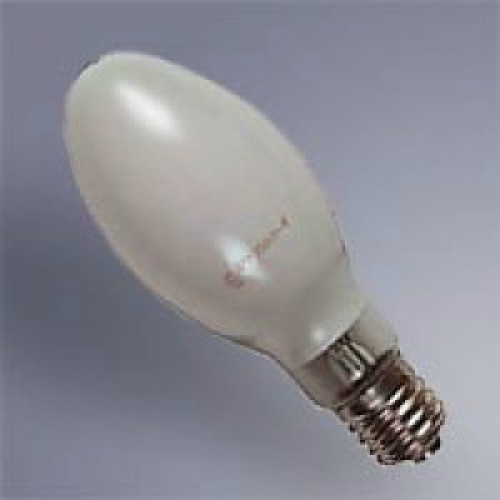
HPS lamps
This type of lighting device is characterized by good luminous efficiency, regardless of the duration of operation of the lamp. Experts do not recommend using these light bulbs for lighting inside production facilities. large space due to the high pulsation of the light flux, as well as the deviation towards the red color of the radiation spectrum - together this affects the color perception of illuminated objects.
Efficient operation of arc sodium lamps possible only under certain conditions:
- stable network voltage;
- lamp operation in the temperature range from –20 to +30 °C.
When luminaires with these lamps are used in other conditions, experts note a significant decrease in luminous efficiency and a decrease in the service life of lighting devices. This type of device depends on the quality of the triggering elements and the internal pressure.
If we consider the issue of replacing DRL with HPS, it can be noted that many consumers form the erroneous opinion that the illumination of the space will become better, and this will be a more economical option, since they do not take into account the fact that replacing DRL with HPS of the same power , you thereby increase the amount of current consumed. It is also necessary to take into account that sodium light sources distort the color rendering of the illuminated object; According to experts, for this reason they cannot be installed on lamps along highways.
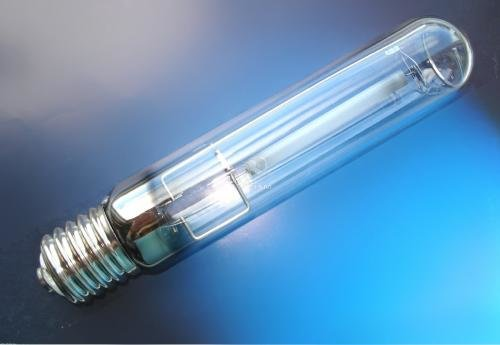
HPS lighting source
High power LED lamps
An analogue of DRL 250, according to experts, should be sought in innovative LED lamps that have a high coefficient useful action, up to 98%. A high-efficiency LED lamp is an energy-saving device with the property of low thermal output.
The technology for producing light radiation provides LED lamps(SD) additional characteristics:
- resistance to temperature fluctuations;
- resistance to mechanical stress;
- insensitivity to power surges;
- They have excellent color rendering of the lighting object, long period efficient work;
- no flicker of light;
- have a positive effect on the environment, being a product of modern technologies.
In order to use this type of lamps at production facilities and for lighting large areas, they are produced with a power of 20 to 150 watts. It is characteristic that the greater the power of the LED lamp, the more additional properties they have. Lamps with power over 60 W have their own cooler, and lamps over 110 W have an electrical power driver.
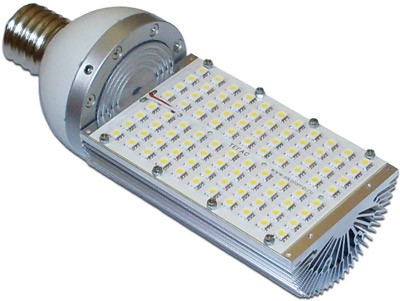
LED device, LED lamp
Comparison table for DRL, HPS, LED lamps:
*The level of 7,500 lm, according to experts, provides illumination similar to a 250-watt DRL lamp; this is determined by the direction of the light flux emanating from the LEDs.
From the illumination of the object it is clear that with a luminous flux of 13 thousand lumens, the object actually illuminates no more than 9 thousand lumens. This is due to the loss of luminous flux on the lamp reflector. Considering that with the same consumption electrical energy If the glow of 250 decreases by half, then an analogue of 7,500 lumens of an LED lamp is quite sufficient.
An analogue of DRL 400 in the LED version can be the “Module” lamp, which has a power of 128 watts and consists of two assemblies of 64 watts each. The luminous flux of this device is 16,000 lumens, the operating capacity is 100,000 hours.
Efficiency of using DRL, HPS and LED lamps
When organizing the illumination of a large space, one must always proceed from correct application lamps, taking into account the conditions of their use.
- DRL lamps are easy-to-use devices that are affordable; it is advisable to use them on objects without special requirements for the quality of illumination.
- Sodium arc lamps have best performance luminous efficiency in the category of gas-discharge lighting sources, but have a low level of color rendering and are dependent on temperature regime. For these reasons, they cannot be used in production workshops or on roads. In other places, the use of this type of lamp is permitted.
- An LED (LED) lamp has one drawback, according to experts - the need to create a heat sink from the light diodes, since possible overheating during operation can affect the crystal with the phosphor. In addition, the power source (driver) of this type of lamp contains capacitors, the operation of which is limited to a time interval of 6–10 thousand hours; after this period there are no guarantees of high-quality lighting. Modern LED lamps use solid-state drivers, which makes it possible to increase the lamp operating time to 50–60 thousand hours.
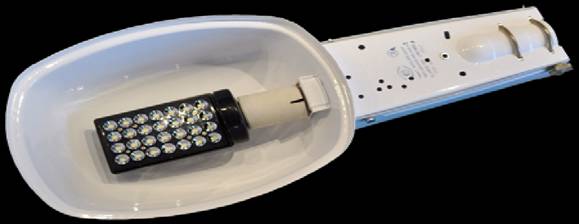
An LED lamp, unlike gas-discharge light sources, does not require a starting current, which affects the choice of wire cross-section when connecting it. It should be noted that currently LED lamps have high cost. The payback for one lamp occurs within a year of its operation when burning for 8–10 hours during the day.
Conclusion
When choosing a lighting device to illuminate an object, one must take into account the fact that DRL and HPS can exhibit an “aging effect” when the luminous flux dims over time. Experts determine the beginning of this period after 400 hours of operation of this type of lamp; they begin to shine at 80% of the declared luminous flux power, and then the glow decreases to 50%.
Today, LED lamps, despite their cost, are increasingly used in lighting large spaces. Taking into account the payback time and duration of operation, they make it possible to save on electrical energy.
Mercury arc lamps type DRL- gas-discharge mercury lamps high pressure, are used for street lighting and lighting of large production areas.
Used in alternating current networks with a voltage of 220 V and a frequency of 50 Hz.
Marking:
D- arc;
R- mercury;
L- lamp.
Specifications:
|
Name |
Lamp voltage, V |
Power, V |
Length, mm (L) |
Diameter, mm (D) |
Base type |
Luminous flux, lm |
Service life, hours |
Connection diagram:
Thanks to the additional electrodes, the lamp does not require an igniter; it is connected to a network with inductive ballasts and ignites directly from a 220-volt network voltage.
The discharge occurs in an internal flask filled with argon.
The radiation spectrum consists of ultraviolet, and blue and green visible spectrum.
The components of the red region of the spectrum are completely absent.
Phosphor layer on inner surface external bulb converts the ultraviolet component into light radiation from the red part of the spectrum.
The process of flaring up the DRL lamps after switching on lasts about seven minutes; the disappearance of voltage leads to the extinguishing of the lamp.
It is impossible to light a hot lamp; the lamp must cool completely.
Advantages:
- high luminous efficiency (up to 60 lm/W)
- compactness, with high unit power
- ability to work at negative temperatures
- long service life (about 15 thousand hours)
The most common type of lamps currently used in street and industrial lighting. Developed earlier than other lamps and the least labor-intensive to manufacture, DRL lamps are widely used for indoor and outdoor lighting. DRL lamps have lower light output compared to HPS lamps, but unlike them, they do not require additional high-voltage triggering devices for ignition. The ergonomic indicators of lighting of DRL lamps (pulsation coefficient of the light flux, correspondence of the emission spectrum to the solar spectrum) are slightly worse than, for example, those of DRI lamps, but much better than those of HPS lamps.
Tubular sodium arc lamps (HPS)
Currently widely used for street lighting, transport routes, public buildings, etc. HPS lamps have the highest luminous efficiency among gas-discharge lamps and a lower luminous flux reduction with long service life. Due to the very high pulsation coefficient and the large deviation of the lamp's emission spectrum into the red region, which disrupts the color rendition of objects, it is not recommended to use HPS lamps for lighting inside industrial and residential premises. The large dependence of the light output and ignition voltage of HPS lamps on the composition and pressure of the internal gas, on the current passing through the lamp and on the burner temperature places very high demands on the quality of manufacture and operating conditions of HPS lamps. Therefore, for efficient operation of HPS lamps, it is necessary to ensure “comfortable” operating conditions - high stability of the supply voltage, ambient temperature from -20°C to +30°C. Deviation from “comfortable” operating conditions leads to a sharp reduction in lamp life and a decrease in light output. The service life of HPS lamps is also affected by the quality of the pulse triggering devices used. Currently, there is a widespread misconception that replacing DRL lamps with more efficient HPS lamps leads to improved lighting quality and energy savings. This does not take into account that a HPS lamp of similar power with a higher luminous flux also has a higher current consumption. In addition, the predominance of the red spectrum from HPS lamps worsens the overall visibility of illuminated objects, which is especially dangerous for lighting high-speed highways.
LED lamps (LED)
LEDs themselves have been used for a long time, mainly for display. Emission of light by an LED by recombination of photons into p-n areas transition of a semiconductor during the passage of current. Unlike other technologies, LEDs have a very high efficiency - at least 90% (95-98%). Most existing technologies involve heating a body or area, which requires a decent amount of energy. Thanks to its high efficiency, LED technology ensures low power consumption and low heat generation. In addition, due to the very nature of receiving radiation, LEDs have a set of characteristics unattainable by other technologies. Mechanical and temperature stability, resistance to voltage surges, long service life, excellent contrast and color rendition. Plus environmental friendliness, no flicker and even light. This is quality modern technology.
Parameters of the types of lamps under consideration:
| Rated power, W | Consumed active power, W | Average burning time, hours | Luminous flux, Lm |
||
| DRL-125 | |||||
| DRL-250 | |||||
| DRL-400 | |||||
| DNAT | DNAT-100 | ||||
| DNAT-150 | |||||
| DNAT-250 | |||||
| DNAT-400 | |||||
| analogue of DRL-125 | up to 100000 | ||||
| analogue of DRL-250 | up to 100000 |
* The luminous flux of 5000 lumens of the LED analogue of the DRL-250 lamp is quite sufficient. This is explained design features lamp and DRL lamp. Light is emitted by the lamp in almost all directions: as a result, it is lost on the reflector of the lamp body, because on the lamp itself, goes where lighting is not required (ceilings, sky, etc. are illuminated). (Fig. 1).
Thus, from those stated in the lamp DRL-250
13,000 Lm, after passing through the lamp body, a maximum of 9,000 Lm remains. And this is only in the first weeks of operation. And after 2-3 months (depending on the intensity of use) the luminous flux on the lamp itself will drop by half. Those. the resulting luminous flux of the lamp will be 4,500 Lm (!). And the level of electricity consumption will remain at the same level.
Comparative characteristics:
| Lamp type | DRL-250 | DNAT-150 | LED lamp |
| Luminous flux, Lm | 5000 |
||
| Consumption, W | 65 |
||
| Service life, hours | Up to 35,000 – 50,000 |
||
| Contrast and color rendering | weak | very weak | excellent |
| Mechanical strength | average | average | excellent |
| Temperature stability | weak | very weak | excellent |
| Resistance to changes | weak | weak | excellent |
| Start-up time | 10-15 minutes | 10-15 minutes | instantly |
| Heats up | strongly | strongly | weak |
| Environmental Safety | the lamp contains up to 100 mg of mercury vapor | the lamp contains sodium-mercury amalgam and xenon | safe |
Note: Under temperature stability This implies how dependent both the operation of the lamp and its service life are on critical temperature values. For example, it is known that a HPS lamp is extremely sensitive to deviations from “comfortable” temperature values. Such deviations negatively affect light output and lead to a sharp reduction in service life.
Analysis:
It is important to highlight one more point that is not mentioned above. DRL and HPS lamps have an aging effect. It is reliably known that after 400 hours of operation the drop in luminous flux of DRL lamps is more than 20%, and by the end of their life it is more than 50%. Most During its service life, the lamp emits only 50-60% of the nominal luminous flux. This can be clearly seen from the luminous flux decay curve. The situation with DNATs is even sadder, due to their lower temperature stability. LEDs don't have this. LEDs maintain their parameters at the original level throughout their entire service life. Only towards the end of the period can a slight drop be observed. This is where an interesting and important point. It turns out that if you measure the parameters, for example, every month during the entire service life, and then calculate the average, it will be about (!) 60% of the nominal value. The declared parameter values concern only the initial period of operation and will constantly fall along the curve from the very beginning. This is nothing more than the costs of existing technologies. The above can be interpreted as follows. For the declared characteristics (primarily the luminous flux), you pay more or pay 100% for characteristics that are actually ~40% lower.
Efficiency of using these types of lamps.
DRL. The simplest and most affordable technology. Low initial costs, provided there are no stringent lighting requirements, justify its use.
DNAT. The best light output among gas-discharge lamps is the only serious advantage over DRL. But a very weak color rendering index and high sensitivity to temperature cast doubt on the feasibility of replacement. HPS is not recommended for use for interior lighting, and in some countries there is even a ban. Lighting roads, especially highways, is also not recommended. When lighting any other areas, the use of HPS lamps can be considered justified compared to DRL.
LED lamp. In fact, the only drawback LED lamps It can be considered necessary to ensure high-quality heat removal from the LEDs themselves. Overheating leads to premature degradation of the crystal and phosphor. The second disadvantage is the presence electrolytic capacitors in LED power supplies (drivers). The average service life of the electrolyte is 6000-10000 hours. Subsequently, the performance of the power source may be unpredictable and the entire lighting system (lamp) may fail. However, the use of new technologies made it possible to avoid this trouble. In particular, these are solid-state drivers from the South Korean company Seoul Semiconductor of the Acrich2 family, which have a lifespan of 85,000 hours, which guarantees a lifespan of the entire lamp of at least 50,000 (Fig. 2).
 Rice. 2
Rice. 2
In addition to the above, we can add that LED lamps do not require inrush currents, and therefore require a smaller cable cross-section. The disadvantages include the cost; they are significantly ahead in price. But taking into account all the factors related to the operating costs of DRL or HPS lamps, the payback period for LED analogues is 8-10 months when used for at least 12 hours a day. After this, you save your money on electricity, replacement of lamps and operation of lamps


